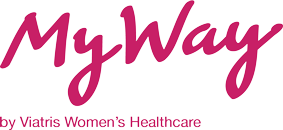
Treatment
Treatment of Menopause
Hormone replacement therapy (HRT) is the mainstay of menopausal treatment. The International Menopause Society (IMS) and British Menopause Society (BMS) recommend the use of the lowest effective dose for symptom control. Arbitrary limits should not be placed on the duration of usage of HRT.1,2
Menopausal treatment is initiated to provide relief from vasomotor symptoms such as hot flushes, night sweats and sleep disturbances. Hormone replacement therapy (HRT) is the most effective treatment for vasomotor symptoms and urogenital atrophy.1,2 HRT may also be beneficial in providing relief from other symptoms of menopause such as joint and muscle pain and mood symptoms.1 However, HRT can be linked with an increased risk of certain conditions, such as breast cancer and venous thromboembolism. Hence the overall balance of benefits and risks of HRT must be considered, and treatment individualised to the woman's needs and preferences.1
Furthermore, clinicians should consider the progestogen when prescribing combined HRT and the beneficial effects of dydrogesterone (contained in Femoston® and Femoston®-conti), are included in different guidelines and recommendations from professional societies and bodies.1-3
What do we have in common?
We all go our own way.
Symptoms of the menopause that may require treatment
Vasomotor symptoms such as hot flushes, night sweats and other symptoms; sleep disturbances, arthralgia, vaginal dryness, dyspareunia, anxiety, irritability and low mood can cause distress to women and negatively affect their quality of life. Therefore, these symptoms may need to be treated.1,4,5
What are the health considerations before initiating menopausal treatment?5
Menopausal women should be counselled regarding smoking cessation and alcohol consumption. The patient should be assessed for risk of osteoporosis, cardiovascular disease (CVD) and breast cancer. Coexisting risk factors such as hypertension, glucose intolerance and dyslipidaemia should be recognised and treated. Counselling regarding maintenance of a healthy lifestyle, which includes a healthy diet and adequate exercise, should be done to reduce the risks of CVD.
HRT for menopausal treatment
HRT remains the most effective therapy for vasomotor symptoms and urogenital atrophy. Additionally, other menopause-related complaints, such as joint and muscle pains, mood symptoms, sleep disturbances and sexual dysfunction may improve during HRT treatment.1
Offer women HRT for vasomotor symptoms after discussing with them the short-term (up to 5 years) and longer-term benefits and risks. Offer a choice of preparations such as; estrogen and progestogen to women with a uterus and estrogen alone to women without a uterus.6
Femoston® and Femoston® conti, contain 17β estradiol and dydrogesterone. Femoston® is indicated for the treatment of estrogen deficiency symptoms in postmenopausal women at least 6 months since last menses and Femoston®-conti is indicated for estrogen deficiency symptoms in postmenopausal women at least 12 months since last menses.7-10
HRT prescribed before the age of 60, or within 10 years of the menopause has a more favourable benefit/risk profile compared to starting HRT later, or in older women.1,2
Osteoporosis is common in postmenopausal women.14 Estrogen deficiency at menopause is associated with increasing bone turnover and loss of bone density.7,8 It is estimated that one in two women in the UK will suffer a fracture after the age of 50 and the International Osteoporosis Foundation reports that a 50-year-old woman has a 2.8% risk of death related to hip fracture during her remaining lifetime.2
HRT has been shown to have a significant protective effect against osteoporosis and related fragility fractures.2 Certain strengths of HRT therapy are indicated for the second line prevention of osteoporosis. Protection appears to be effective for as long as treatment is continued. After discontinuation of HRT, bone mass is lost at a rate similar to that in untreated women.7,8,10
Risks associated with HRT
Breast cancer
The overall evidence shows an increased risk of breast cancer in women taking combined estrogen-progestogen or estrogen-only HRT, that is dependent on the duration of taking HRT.7-10
The Women’s Health Initiative study (WHI), and a meta-analysis are consistent in finding an increased risk of breast cancer in women taking combined estrogen-progestogen for HRT which becomes apparent after about 3 (1-4) years.7-10
Additional results from observational studies and the recent meta analysis from 2019 show that different progestogens may have different risk profiles when it comes to breast cancer risk.11,15-17
Observational studies have shown that estradiol + dydrogesterone (Femoston® and Femoston®-conti) may be associated with a lower risk of breast cancer compared with other synthetic preparations.11,15-17
Venous thromboembolism (VTE)
In general, HRT is associated with 1.3–3-fold risk of developing VTE and occurrence is more likely in first year of HRT.7-10 In a 2019 case control study, the baseline risk of VTE in women is 16 per 10,000 woman-years and use of oral HRT has been shown to increase this risk by 9 extra cases per 10,000 woman-years.12
The occurrence of VTE associated with Femoston® and Femoston®-conti is uncommon (between 1/100 and 1/1,000).7-10
Observational studies have indicated that the type of progestogen used in combination with estradiol may have an important impact on VTE risk.12,13
The Vinogradova 2019 case-control study indicated that amongst the oral combined preparations, estradiol with dydrogesterone (Femoston® and Femoston® conti) was associated with the lowest risk of VTE.12
Non-hormonal options for menopause treatment
Women should be advised to make lifestyle changes and interventions that could help general health and wellbeing. Non-hormonal options could be discussed and non-pharmaceutical options such as cognitive behavioural therapy (CBT) may alleviate low mood or anxiety that arise as a result of the menopause.6
Clinicians should not routinely offer selective serotonin reuptake inhibitors (SSRIs), serotonin and norepinephrine reuptake inhibitors (SNRIs) or clonidine as first-line treatment for vasomotor symptoms alone.6
Explain to women that there is some evidence that isoflavones or black cohosh may relieve vasomotor symptoms. However, explain that:6
- Multiple preparations are available and their safety is uncertain
- Different preparations may vary
- Interactions with other medicines have been reported
-
References
- 1) Baber RJ, Panay N, Fenton AT. 2016 IMS Recommendations on women’s midlife health and menopause hormone therapy. Climacteric. 2016 Apr;19(2):109-50.
- 2) Hamoda H et al. The British Menopause Society & Women’s Health Concern 2020 recommendations on hormone replacement therapy in menopausal women. Post Reproductive Health. October 2020.
- 3) Lambrinoudaki I et al. EMAS position statement: managing obese postmenopausal women [published correction appears in Maturitas. 2011 Jun;69(2):e2]. Maturitas. 2010;66(3):323-326.
- 4) The NAMS 2017 Hormone Therapy Position Statement Advisory Panel. The 2017 hormone therapy position statement of The North American Menopause Society. Menopause (New York, NY). 2017 Jul;24(7):728-753.
- 5) Stuenkel CA, Davis SR, Gompel A et al. Treatment of symptoms of the menopause: an Endocrine Society Clinical Practice Guideline. J Clin Endocrinol Metab. 2015 Nov;100:3975-4011.
- 6) NICE. Menopause: diagnosis and management. NG23. Available at: www.nice.org.uk/guidance/ng23 (accessed September 2021).
- 7) Femoston® 1/10mg. Summary of Product Characteristics.
- 8) Femoston® 2/10mg. Summary of Product Characteristics.
- 9) Femoston® Conti 0.5mg/2.5mg Summary of Product Characteristics.
- 10) Femoston® Conti 1mg/5mg Summary of Product Characteristics.
- 11) Collaborative Group on Hormonal Factors in Breast Cancer. Type and timing of menopausal hormone therapy and breast cancer risk: Individual participant meta-analysis of the worldwide epidemiological evidence. The Lancet. 2019;394(10204):1159–68.
- 12) Vinogradova Y et al. Use of hormone replacement therapy and risk of venous thromboembolism: nested case-control studies using the Qresearch and CPRM databases. BMJ 2019; 364:k4810.
- 13) Canonico M, Oger E, Plu-Bureau G et al. Hormone therapy and venous thromboembolism among postmenopausal women: impact of the route of estrogen administration and progestogens: the ESTHER study. Circulation. 2007;115(7):840–845.
- 14) Eastell R et al, Pharmacological Management of Osteoporosis in Postmenopausal Women: An Endocrine Society Clinical Practice Guideline, The Journal of Clinical Endocrinology & Metabolism. 2019; 104 (5):1595–1622.
- 15) Fournier A et al. Unequal risks for breast cancer associated with different hormone replacement therapies: results from the E3N cohort study. Breast Cancer Res Treat 2008;107(1):103–111.
- 16) Vinogradova Y et al. Use of hormone replacement therapy and risk of breast cancer: nested case-control studies using the QResearch and CPRD databases BMJ 2020; 371 :m3873.
- 17) Lyytinen H, Pukkala E, Ylikorkala O. Breast cancer risk in postmenopausal women using estradiol-progestogen therapy. Obstet Gynecol. 2009;113(1):65–73.

Femoston®
Femoston is a combination of 17β estradiol and dydrogesterone, which is indicated for postmenopausal women at least 6 months since last menses to provide relief from vasomotor symptoms.

HRT TREATMENT NAVIGATOR
An interactive tool to help tailor individual therapy using the Viatris broad portfolio of HRT treatment options. Answer 2-6 simple questions to get an option now.
HCP Disclaimer
This website is intended for UK healthcare professionals only.
Viatris Connect is an online platform for UK healthcare professionals.
Across the website you will find news, blogs and product information.
FREE Menopause and HRT webinars available to watch by registering to Viatris Connect today
Please note that the website contains promotional and non-promotional material including educational content and resources to help you and your patients.
REGISTER NOW


